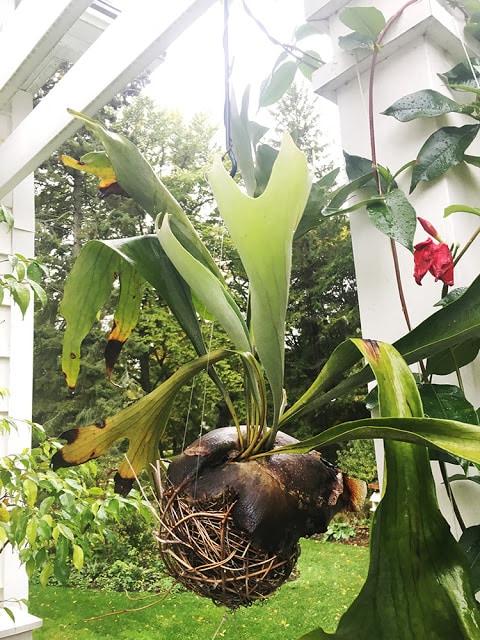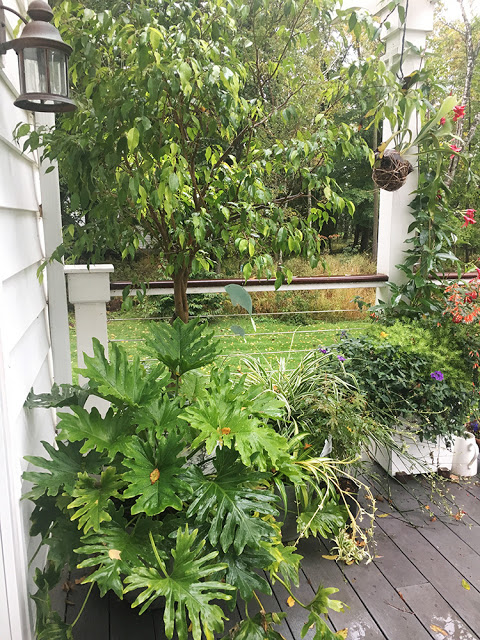It’s a good thing houseplants, in general, survive on benign neglect because that’s certainly what they get in my house. I water less than I should and start fertilizing later than I should. By the time they are summarily shoved out the door onto the deck in June, they are in a sad state.
Still, I strive to keep them alive during the time they are in the house. That mostly means I water them when I remember and fertilize them starting in late winter, also when I remember. It is, perhaps, not exactly the makings of a how-to book.
But I do have a few personal guidelines I follow for bringing my houseplants back in, which is on my agenda for this coming weekend. Nighttime temperatures haven’t dipped much below the low 50s here yet, but they certainly will in coming weeks.
1. I wait as long as I can to bring plants in. This isn’t something you should probably do, as the best thing to do for plants is to gradually acclimate them to their new surroundings. But the fact is, there’s no way I’m going to haul plants in and out, so when they come in, they stay. Because I don’t have a great place for houseplants to live light-wise, I leave them outside for the maximum amount of light they can get.
2. Water them really well, but then let them dry out. That seems counterintuitive, but well-watered plants will manage the stress of the move better than plants that are drought stressed. In a recent podcast with Margaret Roach, Ken Druse said he overwaters all his houseplants before bringing them in to help flush out creepy crawlies that may be camping out. I think it’s a good idea. The drying out part means I won’t be dripping water all over the house and I’ll save my back a little bit.
3. Give them a shower. I give everything a really good spray with the hose the day before I bring things in. This helps get rid of bugs, but also just dirt and pollen that might be laying on the leaves.
4. Clean them up. I prune off any dead or dying leaves before I bring plants inside. This might be a good thing to do for the plant’s health but I just do it because it’s a lot easier to clean that up outside than inside.
 |
| I love my staghorn fern and was happy to see that it shot up several new fronds this summer. That’s good, because the less attractive fronds will be cut off before it comes inside. |
After that it’s just of finding a spot for everything and making sure I have proper trays under all the pots. I have ruined more floors in my life from houseplants so I’ve learned that a $2 plastic tray is a much better option than taking chances when watering.
Most of my plants end up in the east-facing office/den and I do close the heat vent in that room unless we happen to be sitting in it because houseplants don’t really want to be at the temperature we keep the house. It’s still not cool enough or bright enough for them, but it’s the best I can do. And, as I said, I underwater out of forgetfulness, but I believe it’s better for the plants. Think of winter as a time for houseplants to rest, rather than to force them into active growth.
And that’s it. It’s hardly houseplant heaven here, but I do the best I can, and sometimes that’s enough.
If you’re in need of far better houseplant information, check out this article/podcast on A Way to Garden.
What’s your houseplant care plan? If you have any great tips, please share them!



6 Responses
Before I bring my houseplants in for the winter I fill up a bucket with a mixture of Dawn dish washing liquid and warm water. Everything gets doused with this. Not only does this kill or scare out the creepy crawlers from their hiding places on the plants and in the soil, but it’s also a great insecticide! You can also throw in a cup of rubbing alcohol for an even more potent solution.
All my indoor plants are small enough to haul to the dining table, covered with boot trays so they get watered more or less regularly all year round. Drying the boot trays is a challenge in the snow, though, but they will dry overnight if spread out on the floor with the grids propped on the trays' rims. Dumping the puddles and wiping the trays speeds the drying.
I had a good laugh at the title! My wife and I are going through the same process.I have too many plants. But when it is 20 below they make us feel real comfortable in side. With hopes of spring soon. Never enough windows have to improvise with grow lights
Luckily I have a south facing basement window so I cluster all mine in that area–some that behave and have the right footprint get a spot upstairs providing the green I need to get through the winter months. I can't imagine not having plants inside the house!
Have you looked at the number of plants Danger Garden brings in? Exhausting just to read about them. I only have one plant at the moment but it might be time for some ferns and Begonias to liven things up.
No great tips here but the house plant migration begins today. We just installed new flooring. It is the first time in years that I dread bringing in plants. ha… I will soon get over that. I only have 12 plants to place inside. 7 windows to work with. I tell myself this is easy but it always seems complicated. This time of year I begin the dreams of a greenhouse.